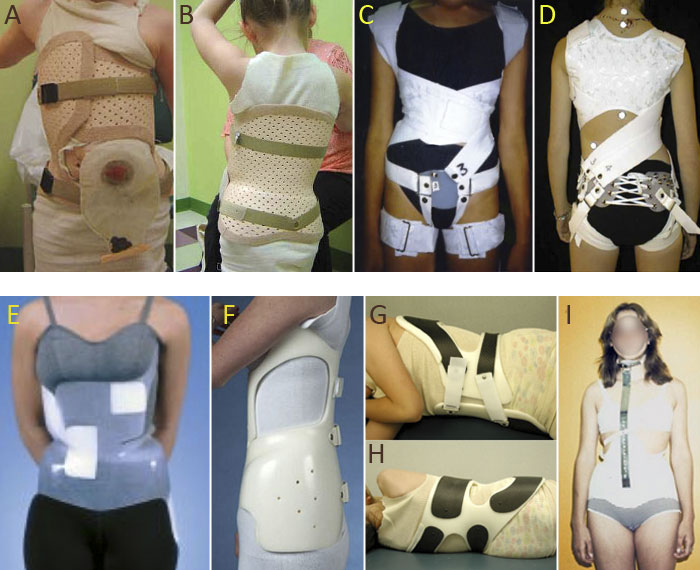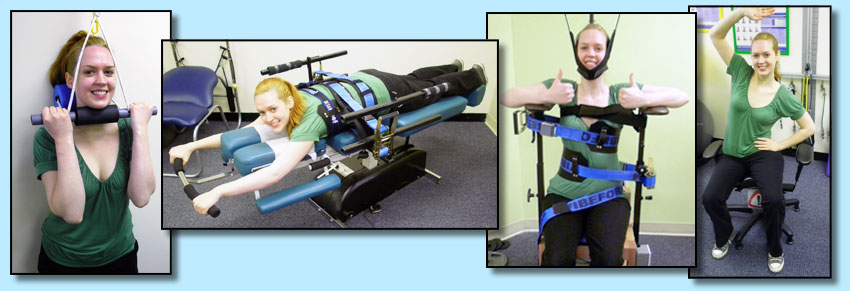Adolescent Idiopathic scoliosis (AIS) is named so because the cause of the scoliosis is unknown. Adolescent children (predominantly girls) begin life with straight spines and over a few months develop scoliotic spine with no changes in lifestyle, diet, and overall health. Early stage idiopathic scoliosis patients’ vertebrae, muscles, ligaments, and discs all appear normal and yet the spine is curved with no known cause. Though there are now known hereditary factors, specifically several chromosomes linked to scoliosis, the role of each chromosome in the expression of scoliosis remains uncertain. There are a great number of studies and hypotheses on what causes scoliosis but the topic remains controversial.
Some scoliosis research [1] [2] has begun to focus on a neurological cause. It is now postulated that a neurological under-development in the postural control centers of the brain stem, coupled with environmental influences, causes AIS.
Popular Non Invasive Methods to Treat AIS
Heel Lifts for Secondary Scoliosis
When a difference in leg lengths causes functional scoliosis, adding shoe wedges or lifts to the heels may be used to treat the scoliosis. A heel lift is a mechanical device which lengthens the shorter leg by a prescribed amount, thereby creating a more level platform or base for the spine to rest on. Unlike heel pads or insoles, heel lifts are made of non-compressible material to allow for precise and constant height increase to one leg. This method works in those rare cases where the short leg is causing the scoliosis.
Full Torso Casting

A fully padded, over-corrective, hard plastic brace has been developed specifically for the infantile case. Yes, it is more expensive to replace the hard plastic brace than the plaster cast as the child grows, but the plastic brace can be removed, allowing for baths and playtime.
Bracing
Traditional Scoliosis braces are commonly prescribed to treat adolescent idiopathic scoliosis with the intent to stop the progression of the spinal curvature. There are many types used. There is much research on issues associated with these older bracing methods such as: patient compliance with treatment, psycho-social impact, and exercise with bracing. Bracing is currently the standard treatment for AIS in curves that are considered to be moderate in their severity and are likely to progress.

One large issue in bracing for scoliosis is patient compliance. Compliance is often affected by psychosocial comfort, exercise, ability to eat and move, pain, and physical deformation. Back braces, especially the Boston brace, put a lot of pressure on the abdomen and can make digestion uncomfortable. Post-operative scoliosis braces and those used for fractures, inhibit motion a great deal making it difficult to do simple tasks like tying shoes or sitting on the floor. Bracing can also be painful and it is possible for some braces to deform the patient’s existing bone structures, especially the hips and rib cages.
One of the main downfalls of traditional scoliosis bracing is that it attempts to treat the curve in the spine but neglects to address the neurological condition (mentioned above) that has produced the curve. In essence it is a band-aid solution to a greater problem because the treatment is essentially passive, it can lead to muscle deterioration and associated weakness.
A new type of brace has recently been released that I use in cases of rapidly progressive curves that are not responsive to an exercise based approach, certain types of postural side shift, and even in adults that are having end of day pain from their scoliosis as gravity takes it’s toll. The need is thankfully rare and I use the brace in approximately 30 percent of cases that I treat.
Controversy over the effectiveness of bracing is somewhat misleading. Most information you read online will be referring to the older brace systems and NOT the modern corrective designs like Cheneau and ScoliBrace. You will never find any doctor in the world claiming that older bracing systems will consistently reduce or correct scoliosis; rather, the debate is over whether or not wearing that type of brace will prevent the scoliosis from getting worse.
Various Physiotherapeutic Methods for the treatment of scoliosis
Pilates
Pilates is a body conditioning routine that helps build flexibility and long, lean muscles, 
Yoga
The purpose of yoga is to create a balance in the body through developing both 
The Schroth Method
The Schroth Method is a physiotherapeutic treatment system which uses isometric and 
Standard Chiropractic Treatment (non scoliosis specialist)
Chiropractic treatment for scoliosis typically consists of spinal manipulation, 
CLEAR Method
The CLEAR Scoliosis Institute is an educational provider of certification and training for the CLEAR Method of scoliosis treatment. Doctors who provide this method are CLEAR certified. They evaluate a patient’s scoliosis to determine what will successfully reduce and stabilize their spinal curvature. To begin they gauge how much resistance exists within the apical regions of the scoliosis, most resistance is created by length of time the curve magnitude has been over 25 degrees, rib deformation, and extent of vertebral rotation. Next the doctor customizes a isotonic and isometric exercise program combined with neuromuscular reeducation program that will challenge the 4th and 5th layer intrinsic muscles enough to effectively reduce and stabilize the spine curvature. Spinal resistance training equipment utilizing innovative scoliosis cantilevers are used to test the different forces. Theses forces cause the spine to adapt in time and in need with the result being a smaller and more stable curvature and in cases of early intervention often a complete elimination of diagnosable scoliosis.
This differs from chiropractic care because general chiropractic care does not use spinal resistance training in conjunction with the principles of autonomic control of the spines alignment.
A 2004 study focused on the reduction of scoliosis by manipulative and rehabilitative methods that involved stimulation of the involuntary postural reflexes utilized in a clinic setting and at home. The results showed reduced scoliotic curvatures in 19 subjects by an average of 17° within a 4 to 6-week period with an average reduction in Cobb angle of 62%. None of the patients’ Cobb angles increased.
As reported in this study, many of the proposed causes of idiopathic scoliosis are neurological. They include: brain asymmetry, neural axis deformities, and central nervous system processing errors. Also, many coexistent neurological alterations are present in scoliosis patients, such as visual deficiency and decreased postural stability [1][2]. Therefore, the goals of treatment are not only to reduce the scoliotic curvatures, but to rehabilitate any underlying postural and neurological weaknesses or imbalance.
Further research is necessary to determine if other environmental influences combine with this genetic predisposition to cause scoliosis and to demonstrate why the most popular methods for treating scoliosis (traditional scoliosis bracing and scoliosis surgery) have poor results and are arguably antiquated. Future scoliosis treatment will hopefully focus on this underlying neuromuscular component of scoliosis and not just the symptom (the curve). Pro-active scoliosis exercise programs in the earliest stages of idiopathic scoliosis are essential.
